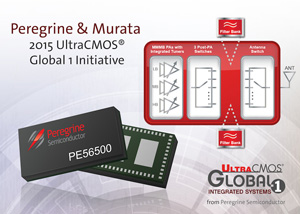- News
2 March 2015
Peregrine and Murata launch 2015 UltraCMOS Global 1 Initiative
Peregrine Semiconductor Corp of San Diego, CA, USA - a fabless provider of radio-frequency integrated circuits (RFICs) based on silicon-on-insulator (SOI) – has teamed with Murata Manufacturing Co Ltd of Kyoto, Japan (its parent company since December) to announce the 2015 UltraCMOS Global 1 Initiative. The campaign launches with the UltraCMOS Global 1 PE56500 product demonstration in hall 2, meeting room 2A28MR at the GSMA Mobile World Congress (MWC2015) in Barcelona, Spain. The new initiative integrates the PE56500 all-CMOS RF front-end solution and Murata filters.
 Picture: Initiative integrates PE56500 all-CMOS RF front-end and Murata filters.
Picture: Initiative integrates PE56500 all-CMOS RF front-end and Murata filters.
"Last year at Mobile World Congress, Peregrine announced the industry's first reconfigurable RF front-end system, UltraCMOS Global 1, and proved that a CMOS power amplifier (PA) could compete with GaAs (gallium arsenide) technology," says Peregrine's president & CEO Jim Cable. "Peregrine's recent acquisition by our long-time partner Murata facilitates the 2015 UltraCMOS Global 1 Initiative and speeds the industry's transition to an integrated, all-CMOS RF front end [RFFE]," he adds.
"Over our 70 year history, Murata has established a reputation as a leading filter and RF module provider," says Norio Nakajima, executive VP, director of Murata's Communication business unit. "Murata holds over 45% of the world's surface acoustic wave (SAW) filter market and over 60% of the connectivity module market," he adds. "By combining Peregrine's Global 1 solution with Murata's industry-leading filters and module capabilities, we can offer the first completely integrated RF front-end solution from a single company," he claims.
UltraCMOS Global 1 technology makes a single, global SKU (stock-keeping unit) possible – saving 4G LTE mobile-device makers significant time and money, it is reckoned. With the new collaboration between Murata and Peregrine, every component required for one SKU would be available from a single company. The UltraCMOS Global 1 Initiative aims to accelerate the transition of LTE mobile-device makers to reconfigurable RFFE designs, which accommodate the world's 40-plus LTE bands on a single chip.
Peregrine says that one of the biggest advantages that Global 1 offers the wireless ecosystem is its ease of tunability for LTE device makers. Before Global 1, RF engineers had to manually solder and tune the RF front end through discrete duplexer matching, which can take anywhere from two weeks to one month (delaying the device's introduction into the market). Global 1 replaces discrete duplexer matching with a tunable matching network that optimizes the PA match across the band. With Global 1 and its supporting software, an engineer can simply plug in the device and use the software to tune the RF front end within a few hours. Additionally, the device remains reconfigurable and can be tuned to another frequency or band to meet market demand. This capability (which is claimed to be unique) will be demonstrated at the Mobile World Congress.
The PE56500 is a fully integrated, reconfigurable 3G/4G cellular RF front-end that includes a multi-mode, multi-band (MMMB) PA, PA tuning, post-PA switch and antenna switch in a single package. It has three monolithic MMMB linear PAs divided into low-, mid- and high-band paths that cover 690–915, 1710–2100 and 2300–2700MHz, respectively. Each of the three paths contain a tunable inter-stage and a final tunable matching network to optimize the performance of the multi-mode PA to the operating cellular band.
The PE56500 is configured through a MIPI RFFE v1.1-compliant digital interface, which enables tunable matching and bias optimization for optimal linearity and efficiency tradeoff. The configurable RF and bias minimize phone variations due to mode, frequency and production tolerances.
Peregrine says that the all-CMOS RF front-end provides easy-to-use digitally controlled adaptation across modes and bands, high isolation to solve interoperability issues, and scalability to easily support higher band counts with low-loss switching and tunability. Built on Peregrine's UltraCMOS 10 technology, the PE56500 combines Peregrine's RF-SOI switch and tuner technology with new CMOS PA capability that delivers raw performance equivalent to GaAs, it is claimed.
The Global 1 PE56500 will be in volume production in late 2015.
Murata completes acquisition of Peregrine
Peregrine to license UltraCMOS IP to Murata for design and manufacture of RF switches


